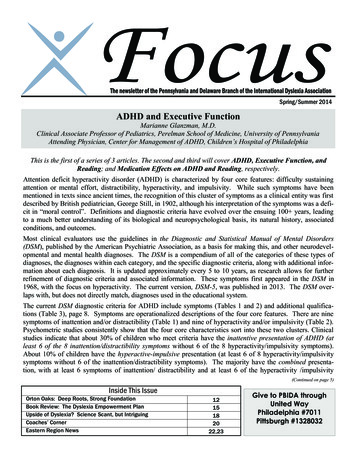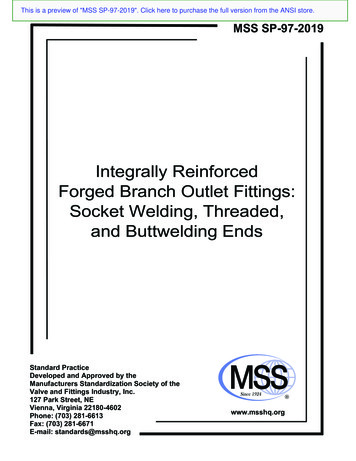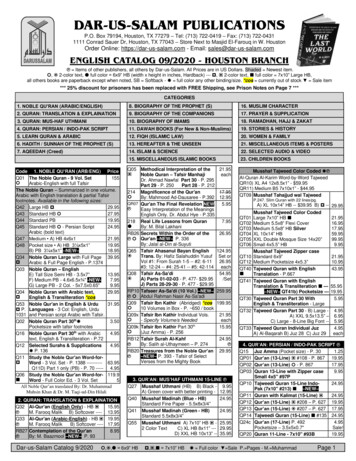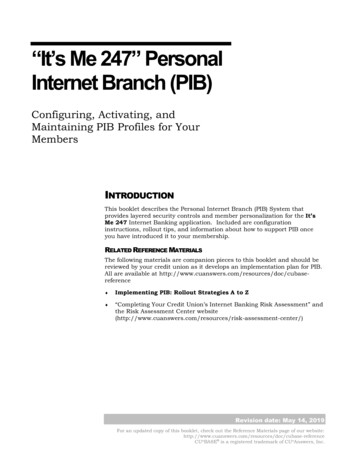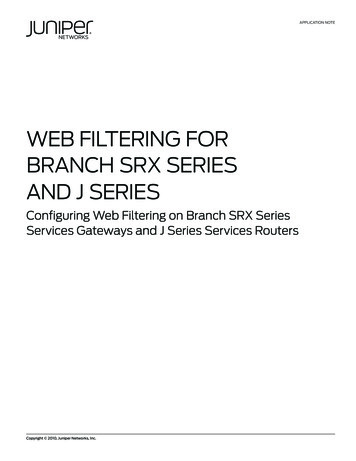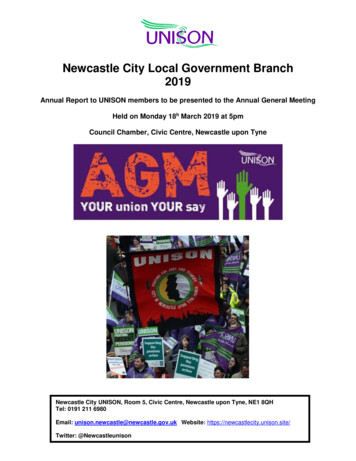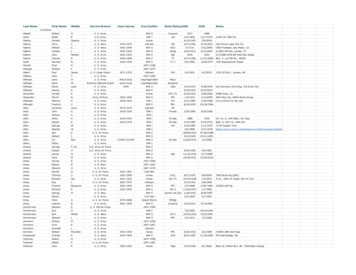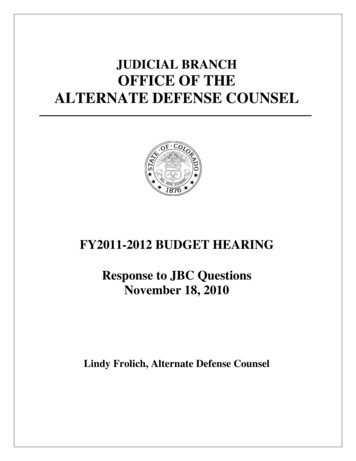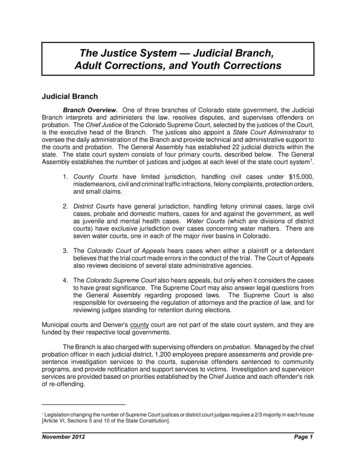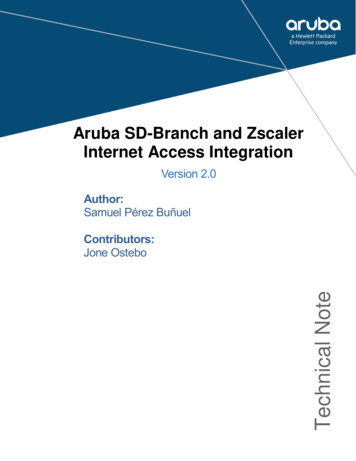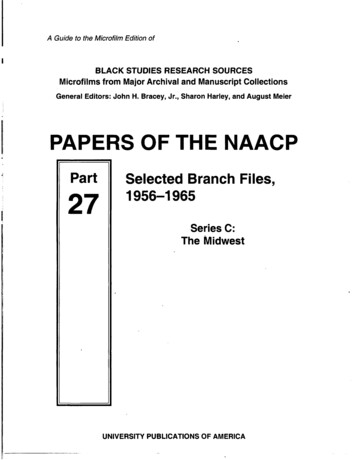
Transcription
A Guide to the Microfilm Edition ofBLACK STUDIES RESEARCH SOURCESMicrofilms from Major Archival and Manuscript CollectionsGeneral Editors: John H. Bracey, Jr., Sharon Harley, and August MeierPAPERS OF THE NAACPPart27Selected Branch Files,1956-1965Series C:The MidwestUNIVERSITY PUBLICATIONS OF AMERICA
A Guide to the Microfilm Edition ofBLACK STUDIES RESEARCH SOURCESMicrofilms from Major Archival and Manuscript CollectionsGeneral Editors: John H. Bracey, Jr., Sharon Harley, and August MeierPAPERS OF THE NAACPPart 27: Selected Branch Files,1956-1965Series C: The MidwestEdited by John H. Bracey, Jr. and Sharon HarleyProject CoordinatorRandolph BoehmGuide compiled byDaniel LewisA microfilm project ofUNIVERSITY PUBLICATIONS OF AMERICAAn Imprint of LexisNexis Academic & Library Solutions4520 East-West Highway * Bethesda, MD 20814-3389
Library of Congress Cataloging-in-Publication DataNational Association for the Advancement of ColoredPeople.Papers of the NAACP. [microform]Accompanied by printed reel guides.Contents: pt. 1. Meetings of the Board of Directors,records of annual conferences, major speeches, andspecial reports, 1909-1950 / editorial adviser, AugustMeier; edited by Mark Fox--pt. 2. Personalcorrespondence of selected NAACP officials, 1919-1939--[etc.]--pt. 27. Selected Branch Files, 1956-1965.1. National Association for the Advancement ofColored People--Archives. 2. Afro-Americans--CivilRights--History--20th century--Sources. 3. AfroAmericans--History--1877-1964--Sources. 4. UnitedStates--Race relations--Sources. I. Meier, August,1923-. II. Boehm, Randolph. III. Title.E185.61 [Microfilm] 973'.049607386-892185ISBN 1-55655-761-2 (microfilm: pt. 27, series C)Copyright 2001 by University Publications of America.All rights reserved.ISBN 1-55655-761-2.
TABLE OF CONTENTSScope and Content NotevSource NoteEditorial NoteAbbreviationsReel IndexixixxiGroup III, Series C, Branch Department FilesGeographical FileReels 1-3Group III, Boxes C-29-C-33Chicago, Illinois, January 1956-December 1963Reel 4Group III, Box C-34Chicago, Illinois, 1964-1965Group III, Box C-39Illinois State Conference, 1956-1958Reel 5Group III, Boxes C-39 cont.-C-41Illinois State Conference, 1959-1963Reel 6Group III, Boxes C-41 cont.-C-42Illinois State Conference, 1964-1965Group III, Box C-45Indiana State Conference, 1956-1965Reel 7Group III, Box C-47Iowa State Conference, 1956-1965Group III, Boxes C-49-C-50Kansas State Conference, 1956-1964Group 111, Box C-63Benton Harbor, Michigan, 1962-1965Reel 8Group 111, Box C-69River Rouge-Ecorse, Michigan, 1956-1961Group III, Box C-70Michigan State Conference, 1956-196513445677888
Group III, Box C-73Minnesota State Conference, 1956-1960.Minnesota-Dakota Conference, 1962-1963Group III, Box C-77St. Louis, Missouri, 1956-1957Reel 9Group III, Boxes C-79-C-80Missouri State Conference, 1956-1965Group III, Box C-117Cincinnati, Ohio, 1960-1961Reel 10Group III, Box C-118Cincinnati, Ohio, 1962-1965Group III, Box C-119Cleveland, Ohio, 1957-1958Reel 11Group III, Boxes C-119 cont.-C-120Cleveland, Ohio, 1959-1965Group III, Box C-121Columbus, Ohio, 1956-1957Reel 12Group III, Boxes C-121 cont.-C-123Columbus, Ohio, July 1958-1963Reel 13Group III, Box C-123 cont.Columbus, Ohio, 1964-1965Group III, Boxes C-127-C-128Ohio State Conference, 1956 June 196188991010101111121213Reel 14Group III, Boxes C-128 cont.-C-129Ohio State Conference, July 1961-1965Group III, Box C-164West Virginia State Conference, 1956-195913Reel 15Group III, Boxes C-164 cont.-C-165West Virginia State Conference, 1960-1965Group III, Box C-167Wisconsin State Conference, 1956-196514Principal Correspondents IndexSubject Index14151727
SCOPE AND CONTENT NOTEThis series of Papers of the NAACP documents the activities of NAACPbranch offices and state conferences in Illinois, Indiana, Iowa, Kansas,Michigan, Minnesota, Missouri, Ohio, West Virginia, and Wisconsin. The filesare arranged alphabetically by state and thereunder by city and span from1956 to 1965.The Branch Department files provide an important local perspective onthe functioning of NAACP branches and state conferences and reveal avibrant movement for civil rights among NAACP branches in the Midwest. Thefiles contain correspondence from the national office to the branches as wellas correspondence and reports generated at the local level and forwarded tothe national office. These files cover a wide variety of local matters such asbranch elections, membership drives, fund-raising, factional disputes, andlocal civil rights initiatives. The most well-documented campaigns in thisedition pertain to schools and employment discrimination.In the Midwest, where de facto rather than de jure segregation wasgenerally the rule, combating de facto segregated schooling emerged as amajor NAACP campaign after 1954. While the Supreme Court's decision inBrown v. Board of Education specifically dealt with de jure segregation, theNAACP used the Brown decision to attempt to overturn de facto schoolsegregation as well. The most well-documented school case in this edition ofbranch files involved the Chicago public schools.The Chicago NAACP branch conducted a lengthy and determinedcampaign to eliminate segregation and discriminatory practices in theChicago schools. Over the ten-year period covered in this edition of Papers ofthe NAACP, the branch's concerns about the Chicago schools essentiallyremained the same. The branch argued that the major problem facing theChicago schools was segregation and that de facto segregation was, in turn,directly linked to other serious problems. These other problems includedovercrowding at the predominantly African American schools, lower spendingfor African American students than for white students, large pupil to teacherratios in the predominantly African American schools, and inferior equipmentand teaching materials at these schools. The Chicago NAACP directedparticularly harsh criticism at the superintendent of the Chicago publicschools, Benjamin C. Willis. In 1965, the branch charged that Willis had failedfor ten years to respond to NAACP demands, and that since 1964 he had notaddressed the problems cited in two separate studies of the Chicago school
system conducted by professors at the University of Chicago. In a February1965 statement, the branch publicly opposed the renewal of Willis's contract,charging that Willis had actually helped to increase racial tensions in the city.Other aspects of the Chicago NAACP's campaign for quality educationconsisted of appearances before and proposals to the Chicago Board ofEducation, meetings with legislators such as Adam Clayton Powell, and filinglawsuits against the Chicago Board of Education.Other files in this edition contain materials about school desegregation inmidwestern locales. The Illinois State Conference files contain a report byeducation chair Faith Rich on de facto segregated schools throughout Illinois.A 1958 report in the West Virginia State Conference files by state conferencepresident T. G. Nutter includes comments by teachers on the process ofschool desegregation in West Virginia. A 1961 report by the state legalredress committee summarizes the status of legal actions in several WestVirginia counties. Additional information on NAACP school desegregationcampaigns can also be found in UPA's Papers of the NAACP, Part 3: TheCampaign for Educational Equality, 1913-1965, and in Papers of the NAACP,Part 23: Legal Department Case Files, 1956-1965, Series C: The Mid- andFar West.Local NAACP activism in the area of employment and employmentdiscrimination is also well documented in this edition of branch files. TheChicago branch records include updates on progress made in opening jobs toAfrican Americans. For example, the 1961 annual report mentions that thebranch filed twenty-five complaints with the Illinois Fair Employment PracticesCommission, and as a result of these efforts, several businesses hired AfricanAmericans. The 1964 annual report notes the opening of new apprenticeshipsin the building trades. In 1963 the Chicago NAACP teamed up with theChicago Urban League in a "talent bank" to identify people with certain skillswho could then immediately apply when jobs opened in their field. The IllinoisState Conference files contain a fact sheet detailing employmentdiscrimination at General Motors. The River Rouge-Ecorse, Michigan, branchfought to secure jobs at the River Rouge Savings Bank. In Cincinnati, Ohio,the branch used direct action and boycotts in an attempt to win jobs for AfricanAmericans. In a March 3, 1960, telephone conversation with NAACP nationalbranch director Gloster B. Current, Cincinnati branch president William Bowenexplained the branch's decision to picket Cincinnati Woolworth and Kressstores. Bowen said that in part the pickets were initiated to support the sit-inmovement in the South, but it was also done because there were no AfricanAmerican employees in thirteen Kress and Woolworth stores in the Cincinnatiarea. The branch used the momentum from these demonstrations to launchactions against other companies with discriminatory employment practices. In1961, efforts primarily focused on The Coca-Cola Company. As of May 18,1961, Coca-Cola employed only two African Americans, both as janitors. The
branch demonstrated at Coca-Cola's factory in Cincinnati and at grocerystores selling Coca-Cola. The slogan for the campaign was "It's No Joke,We're Not Buying Coke." In addition to the campaign against Coca-Cola, thebranch also instituted boycotts against the Avondale-Berling Dairies, theCanada Dry Bottling Company, and the McAlpin Company.The president of the Illinois NAACP State Conference, L. H. Holman, wasparticularly active in combating employment discrimination. For example, inApril 1961, Holman testified before the Illinois Senate's Industrial AffairsCommittee to advocate for the creation of a fair employment practicescommission in Illinois. In his testimony, Holman summarized the findings froman NAACP study on employment discrimination in Illinois. Holman's statisticspainted a fairly dismal picture. In Massac County, where the overallunemployment rate was about 16 percent, the unemployment rate for AfricanAmericans was around 40 percent. At the Electric Energy Company and AlliedChemical Corporation, which together employed over six hundred people,only one employee was an African American. In East St. Louis, Holman said,construction jobs remained reserved for whites, and in Champaign, no AfricanAmericans were employed in professional, management, or supervisorypositions. The Illinois legislature passed a fair employment practices law in1961, but Holman did not cease his activities. In October 1961, he testifiedbefore the Committee on Education and Labor of the U.S. House ofRepresentatives. This time Holman stressed the need for federal fairemployment practices legislation (see Reel 3, Frames 0261-0273). In thissame statement, he also criticized the discriminatory practices of some laborunions. Holman made a more detailed critique of the labor movement in aspeech at the 1964 Illinois NAACP state convention. The speech, entitled"Our New Enemy: Organized Labor," discussed the problem of the exclusionof African Americans from labor unions. Holman said that this exclusion wasbecoming an acute problem because automation was claiming about fortythousand jobs per week in the mid-1960s. Holman recommended taking theemployment fight to the streets. Additional material on the NAACP'srelationship with organized labor may be found in UPA's Papers of theNAACP, Part 13: The NAACP and Labor, 1940-1955, and Papers of theNAACP, Supplement to Part 13: The NAACP and Labor, 1956-1965.In addition to NAACP branch campaigns against discrimination ineducation and employment, the Midwest branch files contain manydiscussions of other branch initiatives and local events. For example, in Cairo,Illinois, NAACP youth council members teamed up with members of theStudent Nonviolent Coordinating Committee in an attempt to desegregate theswimming pool and roller rink in Cairo. In Cincinnati, Ohio, branch memberstried repeatedly to gain entrance to the Coney Island amusement park. As aresult of the demonstrations, on May 27, 1961, Coney Island officials agreedto desegregate all of the amusement park's facilities. Police brutality is also
documented in several branch files. In Columbus and Cincinnati, Ohio, thebranches pressed for the creation of independent civilian review boards. TheBenton Harbor, Michigan, files contain an affidavit by LeRoy Payne, who wasbeaten during questioning at the police station. The reel and subject indices ofthis guide may be consulted for these episodes and other aspects of NAACPactivity in the Midwest.Part 27: Selected Branch Files, 1956-1965, represents a continuation ofthe Selected Branch Files from Part 12 (1913-1939) and Part 26 (1940-1955)of UPA's Papers of the NAACP.While the Branch Department files do provide essential detail on localand state NAACP activity, researchers should be aware that the branch filescan be used most effectively in conjunction with other parts of Papers of theNAACP. Especially relevant in this regard are Part 23: Legal DepartmentCase Files, 1956-1965, Series C: The Mid- and Far West; Part 25: BranchDepartment Files; and Supplement to Part 5, Residential Segregation,General Office Files, 1956-1965. The Legal Department Case Files in Part 23document many of the local cases in great detail. The records in Part 25include regular reports from the NAACP's regional field staff; and Series C ofPart 25 reproduces the printed material and branch newsletters of Midwestbranches. The General Office Files in Supplement to Part 5 contain manyrecords dealing with housing cases in Illinois, Michigan, West Virginia, Iowa,Kansas, Ohio, and Wisconsin. Other parts of UPA's Papers of the NAACP thaiprovide additional material on the period from 1956 to 1965 are the following:* Part 1: Meetings of the Board of Directors, Records of AnnualConferences, Major Speeches, and Special Reports, Supplements for 19561960 and 1961-1965* Part 3: The Campaign for Educational Equality, Series D: Central OfficeRecords, 1956-1965* Supplement to Part 4, Voting Rights, General Office Files, 1956-1965* Supplement to Part 5, Residential Segregation, General Office Files,1956-1965* Supplement to Part 13, The NAACP and Labor, 1956-1965* Supplement to Part 16, Board of Directors File, 1956-1965* Supplement to Part 17, National Staff Files, 1956-1965* Part 19: Youth File, Series D: 1956-1965, Youth Department Files* Part 20: White Resistance and Reprisals, 1956-1965* Part 21: NAACP Relations with the Modem Civil Rights Movement* Part 22: Legal Department Administrative Files, 1956-1965* Part 24: Special Subjects, 1956-1965
SOURCE NOTEAll documents microfilmed for this edition are held by the ManuscriptDivision of the Library of Congress, Washington, D.C. The branch filesselected for this edition were drawn exclusively from Group III (1956-1965),Series C (Branch Department File) of the National Association for theAdvancement of Colored People (NAACP) Records collection.EDITORIAL NOTEProfessors John H. Bracey, Jr. and Sharon Harley compiled this edition ofPapers of the NAACP after a thorough survey of all branch files in Group III ofthe NAACP Records collection at the Library of Congress. Every branchwhose records contained a substantial amount of correspondence regardingsubstantive issues was selected. Each file selected has been reproduced inits entirety. Those branch files that have not been selected for this edition maybe consulted in the original collection at the Library of Congress.
ABBREVIATIONSThe following abbreviations are used throughout this guide.AFL-CIOAmerican Federation of Labor-Congress of Industrial OrganizationsCIOCongress of Industrial OrganizationsCORECongress of Racial EqualityIBEWInternational Brotherhood of Electrical WorkersNAACPNational Association for the Advancement of Colored PeopleSCLCSouthern Christian Leadership ConferenceSNCCStudent Nonviolent Coordinating CommitteeUAWUnited Automobile WorkersYMCAYoung Men's Christian AssociationYWCAYoung Women's Christian Association
REEL INDEXThe following is a listing of the folders comprising Papers of the NAACP, Part 27: Selected BranchFiles, 1956-1965, Series C: The Midwest. The four-digit number on the far left is the frame at which aparticular file folder begins. This is followed by the file title, the date(s) of the file, and the total number ofpages. Substantive subjects are highlighted under the heading Major Topics as are prominentcorrespondents under the heading Principal Correspondents.Reel 1Frame No.Group III, Series C, Branch Department FilesGeographical FileGroup III, Box C-290001 Chicago, Illinois, January-July 1956. 157 pp.Major Topics: Memberships; Leadership Conference on Civil Rights; A. D. Smith; fundraising; support for Montgomery bus boycott; Trumbull Park Homes; CIO; 1958 primaryelection; Freedom Fund; national civil rights legislation; discrimination in public facilities.Principal Correspondents: Marjorie Gregg; Roy Wilkins; Lucille Black; Celia M. Craft;Gertrude Gorman; Gloster B. Current; Archie L. Weaver; Cora M. Patton; Florence E.Wilkinson; Leon Beverly; Vivian Moore; Rose Marie Ashford; Willoughby Abner; Robert L.Birchman.0158 Chicago, Illinois, August-December 1956. 160 pp.Major Topics: Schools; discrimination in public facilities; Clarence M. Mitchell Jr.; Gus Courts;memberships; voter registration; Archie L. Weaver; Roy Wilkins; 1956 Democratic Partyand Republican Party civil rights platforms; civil rights legislation in Congress; Illinois fairemployment practices legislation; William G. Stratton; Richard B. Austin; transportation.Principal Correspondents: Willoughby Abner; Rita Phillips; Faith Rich; Lucille Black; VivianMoore; Gloster B. Current; Anita Cook; Rose Marie Ashford; Gertrude Gorman.Group III, Box C-300318 Chicago, Illinois, January-April 1957. 229 pp.Major Topics: Schools; memberships; Negro History Week; fund-raising; women's auxiliary;Prayer Pilgrimage.Principal Correspondents: Willoughby Abner; Vivian Moore; Gloster B. Current; Marguerite H.Ivy; Rose Marie Ashford; Lucille Black; Willie M. Whiting; Leon Beverly; Archie L.Weaver.0547 Chicago, Illinois, May-October 1957. 160 pp.Major Topics: Archie L. Weaver; Prayer Pilgrimage; Illinois fair employment practiceslegislation; memberships; fund-raising; schools; Willoughby Abner; Coordinating Councilfor Civil Rights.Principal Correspondents: Willie M. Whiting; Lucille Black; Willoughby Abner; Gloster B.Current; Marguerite H. Ivy; Archie L. Weaver; Gertrude Gorman.
07070843Chicago, Illinois, November-December 1957. 136 pp.Major Topics: Memberships; schools.Principal Correspondents: Archie L. Weaver; Willie M. Whiting; Vivian Moore; Marguerite H.Ivy; Gertrude Gorman; Gloster B. Current; Roy Wilkins; Lucille Black; Willoughby Abner;Robert L. Thompson; Carter D. Jones; Sidney Lens.Chicago, Illinois, January-May 1958. 212 pp.Major Topics: Memberships; schools; public relations; women's auxiliary.Principal Correspondents: Willie M. Whiting; Gertrude Gorman; Lucille Black; Marion R.Stewart; Theodore A. Jones; Medgar W. Evers; John A. Morsell; Archie L. Weaver.Reel 2Group III, Series C, Branch Department Files cont.Geographical File cont.Group III, Box C-310001Chicago, Illinois, June-September 1958. 144 pp.Major Topics: Richard J. Daley; memberships; urban renewal; Freedom Fund; 1958 nationalconvention; Cora M. Patton; branch dispute.Principal Correspondents: Gloster B. Current; Lucille Black; Willie M. Whiting; Archie L.Weaver; Theodore A. Jones; Albert L. Nellum; Norene Wallace; Channing H. Tobias;Eleanor Archer-Lofton.0145 Chicago, Illinois, October-December 1958. 191 pp.Major Topics: Branch dispute; memberships; voter registration; schools.Principal Correspondents: Benjamin F. Bell Jr.; Colin A. Cromwell; Gloster B. Current; LucilleBlack
Chicago Urban League in a "talent bank" to identify people with certain skills . relationship with organized labor may be found in UPA's Papers of the NAACP, Part 13: The NAACP and Labor, 1940-1955, and Papers of the . swimming pool and

